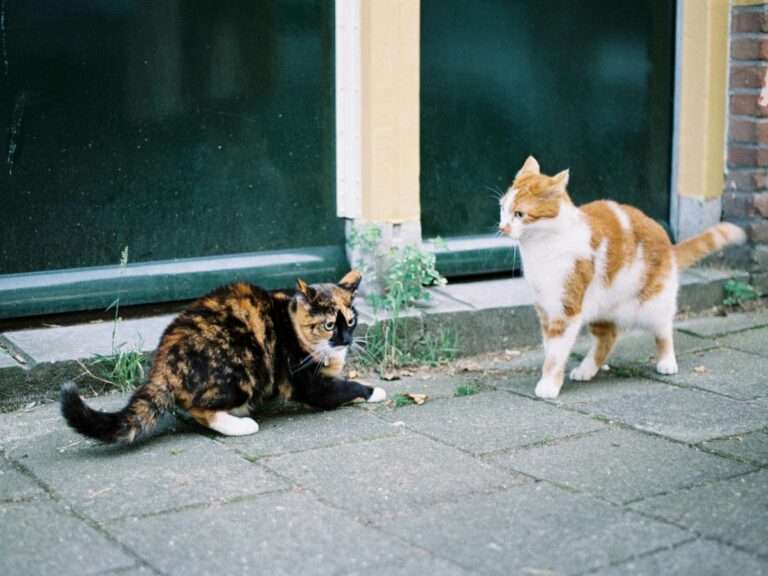It is impossible to estimate how well any particular pair or group of cats will ultimately tolerate each other. Some cats are unusually territorial, and may never adjust to sharing their house, doing best in a one-cat family; while other cats can live well together in a multi-cat family. The factors that determine how well cats will get along are not fully understood. Early experiences for instance can greatly influence a cat’s temperament. A cat that was well-socialized (had pleasant experiences with other cats during kittenhood) is likely to be more sociable than those that haven’t been around many other cats. Also “street cats” that are in the habit of fighting with other cats in order to defend their territory and food resources, may never adjust to living in a multi-cat household. Genetic factors can also influence a cat’s temperament, so friendly parents are probably more likely to produce friendly offspring.
If aggression does occur however, it is important to know that most aggressive problems between cats can be successfully resolved. You may need help from both your veterinarian and from an animal behavior specialist who is knowledgeable in cat behavior. Cats with aggression problems may never be best friends, but can often learn to mutually tolerate each other with minimal conflict. Working with aggression problems between family cats will take time and commitment from you. Don’t give up without consulting the appropriate experts.
Common Types of Aggressive Behaviors Between Cats
Territorial Aggression: Cats are very territorial, by nature. Territorial aggression occurs when a cat feels that his territory/survival is threatened. Depending on where your cat spends his time, he may view your whole neighborhood as his territory. The behavior patterns in this type of aggression include chasing and ambushing the intruder, as well as hissing and swatting when contact occurs. Territorial problems often occur when a new cat is brought into a household, when a young kitten reaches maturity, or when a cat encounters neighborhood cats outside. It’s not uncommon for a cat to be territorially aggressive toward one cat in a family, and friendly and tolerant to another.
Intermale Aggression: Intact adult male cats tend to threaten, and sometimes fight with other males. These behaviors can occur as sexual challenges over a female. This type of aggression involves ritualized body posturing, stalking, staring, yowling, and howling. Attacks are usually avoided if one cat “backs down” and walks away. If an attack occurs, the attacker will usually jump forward, directing a bite to the nape of the neck, while the opponent falls to the ground on his back and attempts to bite and scratch the attacker’s belly with his hind legs. The cats may roll around biting and screaming, suddenly stop, resume posturing, fight again or walk away. Cats don’t usually severely injure one another this way, but you should always check for puncture wounds which are prone to infection.
Defensive Aggression: Defensive aggression occurs when a cat is attempting to protect himself from an attack he believes he cannot escape. This can occur in response to punishment or the threat of punishment from a person, an attack or attempted attack from another cat, or anytime he feels threatened or afraid. Defensive postures include crouching with the legs pulled in under the body, laying the ears back, tucking the tail, and possibly rolling slightly to the side. Continuing to approach a cat that’s in this posture is likely to precipitate an attack.
Redirected Aggression: This type of aggression is directed toward another animal that didn’t initially provoke the behavior. For example, a household cat sitting in the window may see or be threatened by an outdoor cat. Because he can’t respond respectively to the outdoor cat, he may instead turn and attack the other family cat that’s sitting next to him in the window. Redirected aggression can be either offensive or defensive in nature and can occur up to 24 hours after the initial sighting or incident with the outdoor cat.
What You Can Do
- If your cat’s behavior changes suddenly, your first step should always be to contact your veterinarian for a thorough health examination. Cats often hide symptoms of illness until they’re seriously ill. Any change in behavior may be an early indication of a medical problem.
- Spay or neuter any intact pets in your home. The behavior of one intact animal can affect all of your pets.
- Prevent future fights. This may mean keeping the cats totally separated from each other while you’re working on the problem, or at least preventing contact between them in situations likely to trigger a fight.
- Start the slow introduction process over from the beginning (see our handout: “Introducing Your New Cat to Your Resident Cat”). You may need professional help from an animal behavior specialist to successfully implement these techniques. In some situations, when you introduce cats to each other, one of them may send “play” signals which can be misinterpreted by the other cat as aggression. Make sure to provide both cats with plenty of opportunities to play (see our handout: “Play With Your Cat”).
- There are products being marketed by reputable companies to help with stress relief in cats. Please note that none of these products are an automatic cure, rather should be used in conjunction with behavior modification techniques. Please see our handout “Stress Relief for Your Pet” for more information.
- In extreme cases, consult with your veterinarian about medicating your cats while you’re working with them on a behavior modification program. Your veterinarian is the only person who is licensed and qualified to prescribe any medication for your cats. Don’t attempt to give your cat any over-the-counter or prescription medication without consulting with your veterinarian. Animals don’t respond to drugs the same way people do, and a medication that may be safe for a human could be fatal to an animal. Keep in mind that medication by itself isn’t a permanent solution, and should only be used in conjunction with behavior modification.
What Not to Do
- If your cats are fighting, don’t allow the fights to continue. The more often cats fight, the worse the problem is likely to become. To stop a fight in progress, make a loud noise or throw a blanket over them to separate the cats. Don’t try to pull them apart.
- Don’t punish the cats involved. Punishment is likely to elicit further aggression and fearful responses, which will only make the problem worse. If you attempt punishment, you may become a target of redirected and defensive aggression.

